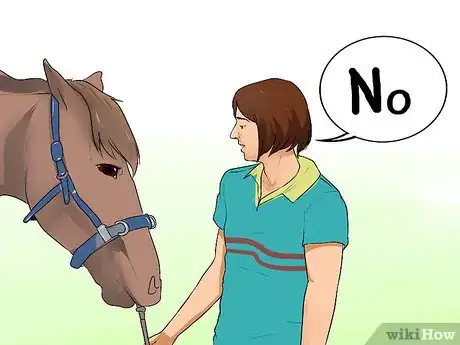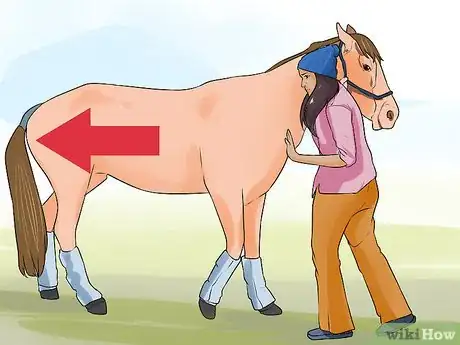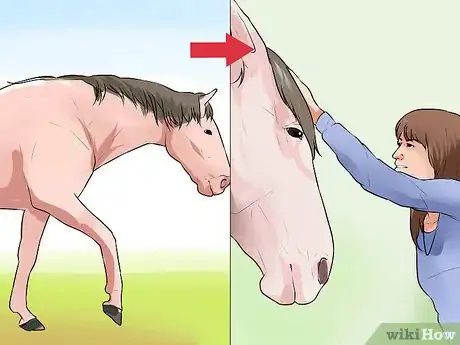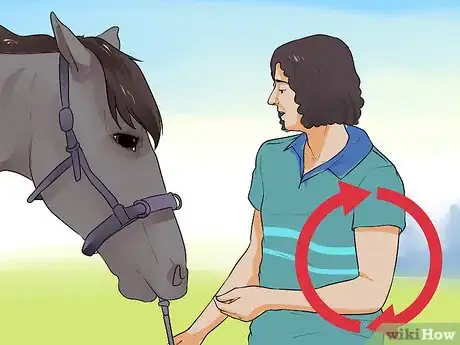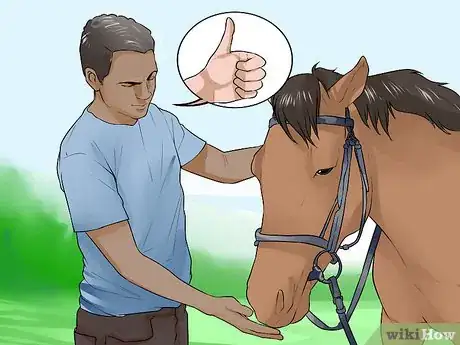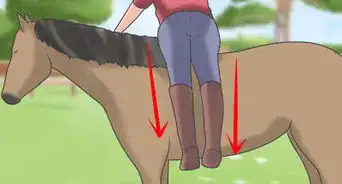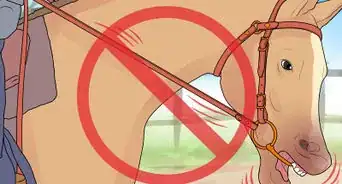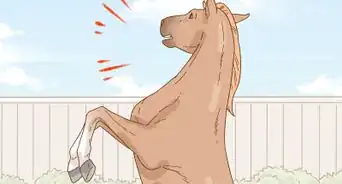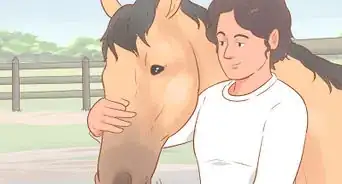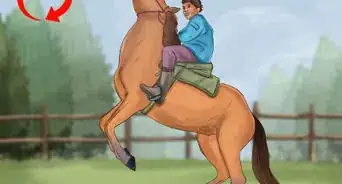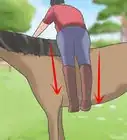This article was co-authored by Ryan Corrigan, LVT, VTS-EVN. Ryan Corrigan is a Licensed Veterinary Technician in California. She received her Bachelor of Science in Veterinary Technology from Purdue University in 2010. She is also a Member of the Academy of Equine Veterinary Nursing Technicians since 2011.
There are 12 references cited in this article, which can be found at the bottom of the page.
wikiHow marks an article as reader-approved once it receives enough positive feedback. In this case, 95% of readers who voted found the article helpful, earning it our reader-approved status.
This article has been viewed 79,068 times.
Working with and training horses can be a very rewarding experience, but it is no easy task. It is important to learn how to correct and teach your horse in an effective, non-threatening manner. Horses are aware and are very sensitive to the body language of those around them. Using physical discipline to correct a horse’s behavior, such as shouting or hitting, can cause harm to the horse both physically and mentally. A talented trainer can control, discipline, and reward a horse by using non-threatening body language. Used with judgement, skill and timing, proper discipline can foster a positive relationship between the horse and the trainer.
Steps
Reacting Immediately to Unwanted Behavior
-
1React immediately. When your horse participates in unwanted behavior, it is important to react within 2-3 seconds. Horses are only aware of immediate, in-the-moment reactions, so disciplining your horse at a later time will not help the horse understand that its behavior was unwelcome.[1]
-
2Utilize the pressure and release method. Using the pressure and release method describes the methodical application of pressure to promote obedient behavior and is a nonaggressive way to correct your horse. Pressure must be applied with purpose and with a specific outcome in mind, and the key is knowing when to release the pressure. You should release immediately when the horse tries to correct its behavior. The horse will see this as a reward for listening to your command.
- While in the saddle, you can apply pressure with your legs. If your horse does not want to stop, move your legs slightly behind where they usually rest and apply soft pressure with both knees to stop your horse.[2]
- If a horse does not want to go left down a path, apply pressure with your right leg. Horses will move away from the side where the pressure is felt. In this case, the horse will begin to veer toward the left path.[3]
- A horse should respond calmly when the release method is used correctly. With time, the horse will become more responsive and willing to listen to your commands.
Advertisement -
3Stand your ground. Use your body language and stance to let the horse know its behavior is unacceptable. Stand squarely in front of the horse and look it in the eye. This will assert that you are alpha, the horse’s leader. Remain calm so that the horse will respond to your behavior in a positive manner.
-
4Use your voice. When your horse needs to be disciplined, remain calm, and say a simple, but firm, “No.” Do not shout at the horse.[4] Use this command consistently, and the horse will begin to understand that this means it needs to behave. Horses are very responsive to your tone and so you can use this as an effective training tool.
-
5Have the horse move backward. Place your hand on the horse’s chest and calmly ask it to move back. Horses do not like walking backward, and using motion to gain control of your horse is a nonthreatening form of discipline.[5]
- To make your horse move backward you should squeeze either depression in your horse’s chest where the point of the shoulder meets the pectoral muscles. Applying slight pressure here will make your horse back up, which reinforces that you are in control without being violent. If your horse is challenging you or displaying unwanted behavior make it back up for as long as it takes for your horse to recognize you as being in charge.
Using Reinforcement Instead of Punishment
-
1Create a positive atmosphere. Demonstrate to the horse that it is in a positive atmosphere and that you are trustworthy. Pulling on the reins, kicking the horse’s side, raising your voice, or using your spur will only teach the horse that it is not pleasant to be around you.[6] The horse will be less likely to respond to your commands and training efforts in a favorable manner if you are hostile, reactive, and harsh.
- Be calm and consistent. If you speak to the horse in a calm manner, don't ride your horse when you are stressed, and practice consistency in the commands you give, the horse will relax, and eventually the relaxation will grow into trust.[7]
-
2Shape the horse’s behavior. Shaping is a technique that is helpful for horses that do not know what response you are looking for.[8] If you overstress what is incorrect, the horse’s excitement level will rise, which will interfere with its ability to think through and complete the command or exercise. When you use this technique, you gradually influence the horse to complete the desired behavior, rewarding it with praise each time it gets closer to completing the task. Slightly emphasize one of your cues to remind the horse of what you are asking it to do. This technique will minimize the horse’s confusion and distress.[9]
- The shaping technique is useful when teaching your horse a new task. If you are training it to walk into a trailer, for instance, reward the horse for taking a few steps toward it. On the next go, you would reward the horse for walking up the ramp. Finally, reward the horse when the horse enters the trailer.[10] This incremental system of rewards will help the horse understand your expectations.
- If you reach a point while shaping where the horse seems to be reaching a wall and is continually not doing what you ask of it then stop the training session for the day and resume it another time, when the horse is calm.
- Keep your training sessions short, 10 - 15 minutes, so that your horse stays focused and motivated.
-
3Practice consistency. Consistency is key in training a horse and establishing good behavior. Be sure not to send your horse mixed signals by frequently changing your technique, cues, or expectations. If you are reprimanding your horse for a particular behavior, be sure to consistently correct it on each occasion. If you let it slide once, your horse may lose sight of the big picture and the lessons will be lost.
-
4Reward the horse for good behavior. If your horse completes a task correctly and does what you ask, give it a reward. Eventually, the horse will learn that it is beneficial and worthwhile to listen to your commands.[11] The horse must believe that you care about it and its needs before it will perform the tasks you ask it to do.[12]
- Reward a horse by stroking or scratching its neck or sides, praising it, or giving it a small piece of fruit or vegetable as a treat.[13]
Controlling Your Body Language and Emotions
-
1Remain calm. It can be frustrating when a horse is consistently misbehaving, but it is important to remain calm and steady. Horses will be able to sense when you are tense, stressed, or anxious. Be sure that your shoulders are relaxed and that your posture isn’t stiff with tension.
- If your horse is biting or rears up, it is important to control your breathing to help you release any anxiety and fear. Steady your breathing by counting to 10 as you breathe in and out. Breathing deeply will help you control your emotions, help you remain calm, and will put your horse in a peaceful state as well.[14]
- If you are feeling tense during your ride, do some stretches while in the saddle. Release your shoulders and slowly lift and lower your thighs from the saddle. When the horse has stopped moving, stretch your back forward toward the saddle horn and backward, and be sure to flex your ankles.[15]
- If you feel you are losing your patience either while riding or training from the ground and feel like you aren’t making any progress these are signs you should stop training for the day and return another time. If you are feeling impatient and frustrated it is likely your horse is too.
-
2Speak to your horse in a calm voice. Speaking in a pleasant, gentle voice has a calming influence on horses. A stern, low tone has been shown to increase a horse’s heart rate and cause distress.[16] Be sure to speak to your horse in a calm, friendly manner to keep the horse's heart rate down and create a safe, pleasant environment.
-
3Refrain from interacting with a horse if you are stressed. If you are angry or stressed, that is probably not the best time to work with your horse. Your horse will pick up on your mood and will react negatively.[17] Understanding and controlling your own reactions, emotions, and moods will benefit both you and the horse.
- Before working with a horse, imagine placing all your stress and the bad aspects of your day in a corner where they will stay during the remainder of your ride. This visualization technique can help you relax mentally so you can focus your attention to your horse.[18] With time and consistency, this technique will help improve your ride and will provide an escape from the stress of everyday life.
-
4Read up on horse behavior and body language. It is key to have a good basic understanding of horse’s body language and how they communicate so that you can better understand the signals your horse is giving you. This will help with getting a better feel as to how your discipline, reward, and overall training strategies are going. There are videos and books that can help you understand the horse-human relationship.
References
- ↑ https://pethelpful.com/farm-pets/horsetrainingdisciplineabuse
- ↑ http://animals.mom.me/steer-horse-reins-3105.html
- ↑ http://animals.mom.me/steer-horse-reins-3105.html
- ↑ https://www.horsejournals.com/discipline-trail-horse
- ↑ https://www.horsejournals.com/discipline-trail-horse
- ↑ http://www.meredithmanor.edu/features/articles/drm/punish.asp
- ↑ http://www.meredithmanor.edu/features/articles/drm/punish.asp
- ↑ https://www.merckvetmanual.com/horse-owners/behavior-of-horses/treatment-of-behavior-problems-in-horses#v42602241
- ↑ http://www.horse-canada.com/magazine_articles/positive-reinforcement-where-does-it-fit-in-equine-training/
- ↑ https://www.merckvetmanual.com/horse-owners/behavior-of-horses/treatment-of-behavior-problems-in-horses#v42602241
- ↑ http://www.horsemagazine.com/thm/2016/04/andrew-mclean-on-punishment/
- ↑ http://www.equisearch.com/article/horse-psychology-and-behavior-part-i-18740
- ↑ http://www.horse-canada.com/magazine_articles/positive-reinforcement-where-does-it-fit-in-equine-training/
- ↑ https://equinewellnessmagazine.com/emotions/
- ↑ http://www.meredithmanor.edu/features/articles/nancy/horse-relaxation-techniques.asp
- ↑ http://www.j-evs.com/article/S0737-0806(13)00217-7/fulltext?mobileUi=0
- ↑ https://equinewellnessmagazine.com/emotions/
- ↑ http://www.meredithmanor.edu/features/articles/faith/relaxation.asp
- ↑ https://pethelpful.com/farm-pets/horsetrainingdisciplineabuse
- ↑ https://pethelpful.com/farm-pets/horsetrainingdisciplineabuse



